Training Need Analysis Report: HSBC, Benefits and Areas
VerifiedAdded on 2022/11/01
|8
|1938
|365
Report
AI Summary
This report provides a comprehensive analysis of Training Need Analysis (TNA), exploring its critical benefits for organizations. It highlights how TNA helps identify performance gaps, align training with organizational objectives, and reduce the risk of training failure. The report then delves into a case study of HSBC, detailing the company's TNA process, which includes setting desired outcomes, evaluating employee skills, and addressing performance gaps through training and development initiatives. Furthermore, the report identifies key areas of training within HSBC, such as human resource development, safety and health, and customer service, emphasizing the importance of tailored training programs to meet specific employee needs and enhance overall organizational effectiveness. The report concludes by referencing relevant literature to support the findings.

[Training need analysis]
q
2019
q
2019
Paraphrase This Document
Need a fresh take? Get an instant paraphrase of this document with our AI Paraphraser

Training need analysis
Table of Contents
Critical benefits of TNA.....................................................................................................1
TNA of HSBC....................................................................................................................2
Key area of training in HSBC based on TNA....................................................................3
References..................................................................................................................................5
1
Table of Contents
Critical benefits of TNA.....................................................................................................1
TNA of HSBC....................................................................................................................2
Key area of training in HSBC based on TNA....................................................................3
References..................................................................................................................................5
1
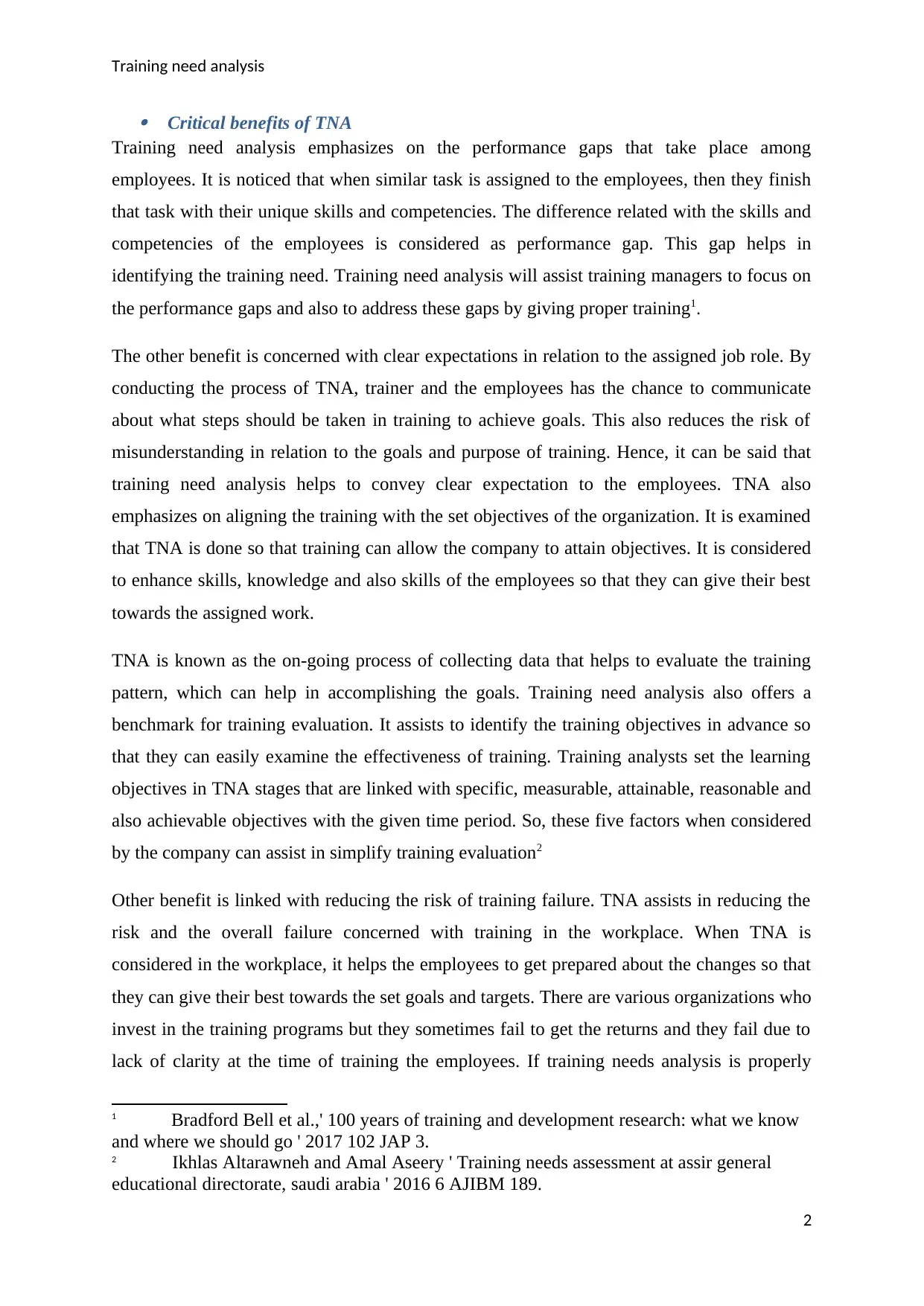
Training need analysis
Critical benefits of TNA
Training need analysis emphasizes on the performance gaps that take place among
employees. It is noticed that when similar task is assigned to the employees, then they finish
that task with their unique skills and competencies. The difference related with the skills and
competencies of the employees is considered as performance gap. This gap helps in
identifying the training need. Training need analysis will assist training managers to focus on
the performance gaps and also to address these gaps by giving proper training1.
The other benefit is concerned with clear expectations in relation to the assigned job role. By
conducting the process of TNA, trainer and the employees has the chance to communicate
about what steps should be taken in training to achieve goals. This also reduces the risk of
misunderstanding in relation to the goals and purpose of training. Hence, it can be said that
training need analysis helps to convey clear expectation to the employees. TNA also
emphasizes on aligning the training with the set objectives of the organization. It is examined
that TNA is done so that training can allow the company to attain objectives. It is considered
to enhance skills, knowledge and also skills of the employees so that they can give their best
towards the assigned work.
TNA is known as the on-going process of collecting data that helps to evaluate the training
pattern, which can help in accomplishing the goals. Training need analysis also offers a
benchmark for training evaluation. It assists to identify the training objectives in advance so
that they can easily examine the effectiveness of training. Training analysts set the learning
objectives in TNA stages that are linked with specific, measurable, attainable, reasonable and
also achievable objectives with the given time period. So, these five factors when considered
by the company can assist in simplify training evaluation2
Other benefit is linked with reducing the risk of training failure. TNA assists in reducing the
risk and the overall failure concerned with training in the workplace. When TNA is
considered in the workplace, it helps the employees to get prepared about the changes so that
they can give their best towards the set goals and targets. There are various organizations who
invest in the training programs but they sometimes fail to get the returns and they fail due to
lack of clarity at the time of training the employees. If training needs analysis is properly
1 Bradford Bell et al.,' 100 years of training and development research: what we know
and where we should go ' 2017 102 JAP 3.
2 Ikhlas Altarawneh and Amal Aseery ' Training needs assessment at assir general
educational directorate, saudi arabia ' 2016 6 AJIBM 189.
2
Critical benefits of TNA
Training need analysis emphasizes on the performance gaps that take place among
employees. It is noticed that when similar task is assigned to the employees, then they finish
that task with their unique skills and competencies. The difference related with the skills and
competencies of the employees is considered as performance gap. This gap helps in
identifying the training need. Training need analysis will assist training managers to focus on
the performance gaps and also to address these gaps by giving proper training1.
The other benefit is concerned with clear expectations in relation to the assigned job role. By
conducting the process of TNA, trainer and the employees has the chance to communicate
about what steps should be taken in training to achieve goals. This also reduces the risk of
misunderstanding in relation to the goals and purpose of training. Hence, it can be said that
training need analysis helps to convey clear expectation to the employees. TNA also
emphasizes on aligning the training with the set objectives of the organization. It is examined
that TNA is done so that training can allow the company to attain objectives. It is considered
to enhance skills, knowledge and also skills of the employees so that they can give their best
towards the assigned work.
TNA is known as the on-going process of collecting data that helps to evaluate the training
pattern, which can help in accomplishing the goals. Training need analysis also offers a
benchmark for training evaluation. It assists to identify the training objectives in advance so
that they can easily examine the effectiveness of training. Training analysts set the learning
objectives in TNA stages that are linked with specific, measurable, attainable, reasonable and
also achievable objectives with the given time period. So, these five factors when considered
by the company can assist in simplify training evaluation2
Other benefit is linked with reducing the risk of training failure. TNA assists in reducing the
risk and the overall failure concerned with training in the workplace. When TNA is
considered in the workplace, it helps the employees to get prepared about the changes so that
they can give their best towards the set goals and targets. There are various organizations who
invest in the training programs but they sometimes fail to get the returns and they fail due to
lack of clarity at the time of training the employees. If training needs analysis is properly
1 Bradford Bell et al.,' 100 years of training and development research: what we know
and where we should go ' 2017 102 JAP 3.
2 Ikhlas Altarawneh and Amal Aseery ' Training needs assessment at assir general
educational directorate, saudi arabia ' 2016 6 AJIBM 189.
2
⊘ This is a preview!⊘
Do you want full access?
Subscribe today to unlock all pages.

Trusted by 1+ million students worldwide
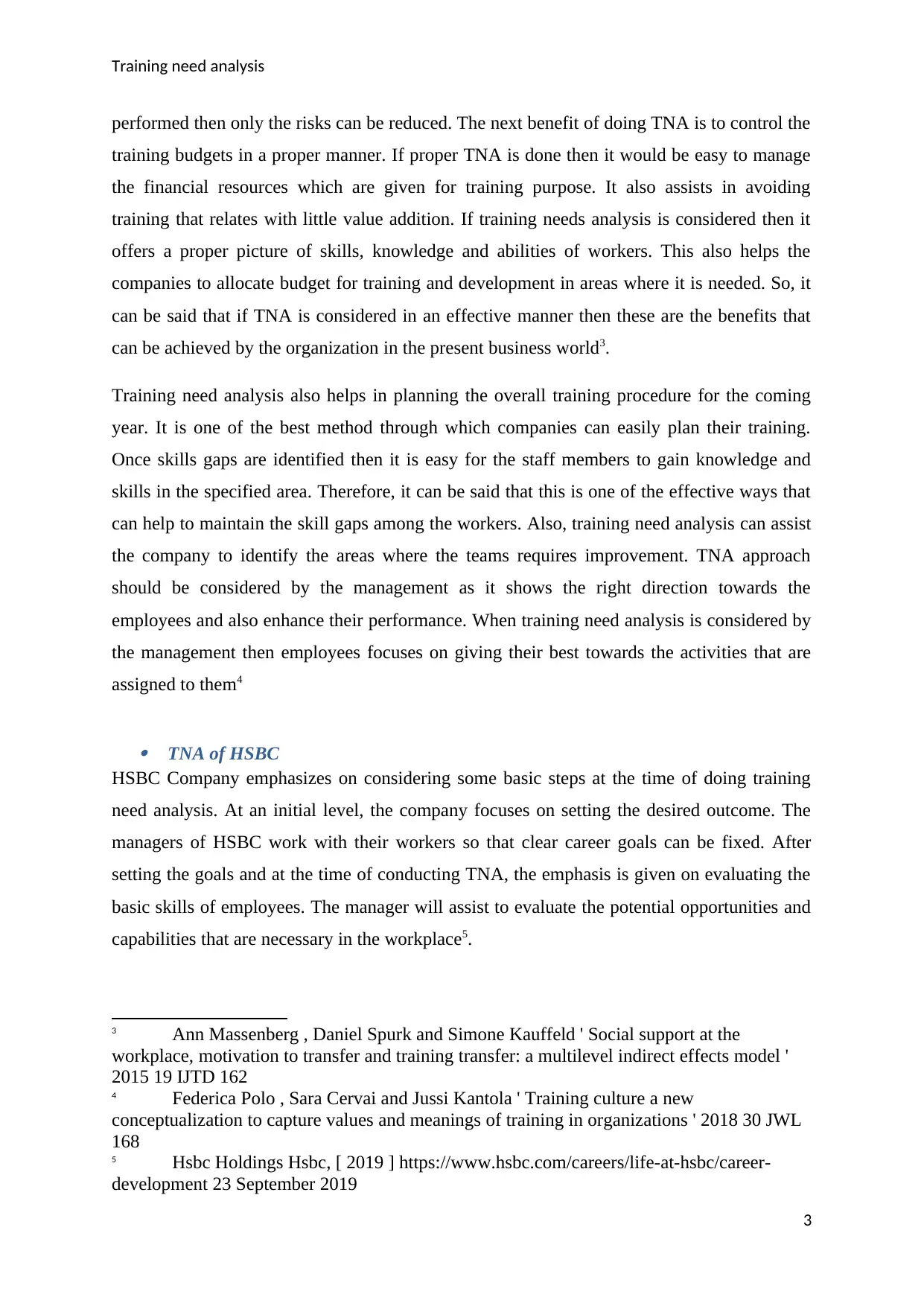
Training need analysis
performed then only the risks can be reduced. The next benefit of doing TNA is to control the
training budgets in a proper manner. If proper TNA is done then it would be easy to manage
the financial resources which are given for training purpose. It also assists in avoiding
training that relates with little value addition. If training needs analysis is considered then it
offers a proper picture of skills, knowledge and abilities of workers. This also helps the
companies to allocate budget for training and development in areas where it is needed. So, it
can be said that if TNA is considered in an effective manner then these are the benefits that
can be achieved by the organization in the present business world3.
Training need analysis also helps in planning the overall training procedure for the coming
year. It is one of the best method through which companies can easily plan their training.
Once skills gaps are identified then it is easy for the staff members to gain knowledge and
skills in the specified area. Therefore, it can be said that this is one of the effective ways that
can help to maintain the skill gaps among the workers. Also, training need analysis can assist
the company to identify the areas where the teams requires improvement. TNA approach
should be considered by the management as it shows the right direction towards the
employees and also enhance their performance. When training need analysis is considered by
the management then employees focuses on giving their best towards the activities that are
assigned to them4
TNA of HSBC
HSBC Company emphasizes on considering some basic steps at the time of doing training
need analysis. At an initial level, the company focuses on setting the desired outcome. The
managers of HSBC work with their workers so that clear career goals can be fixed. After
setting the goals and at the time of conducting TNA, the emphasis is given on evaluating the
basic skills of employees. The manager will assist to evaluate the potential opportunities and
capabilities that are necessary in the workplace5.
3 Ann Massenberg , Daniel Spurk and Simone Kauffeld ' Social support at the
workplace, motivation to transfer and training transfer: a multilevel indirect effects model '
2015 19 IJTD 162
4 Federica Polo , Sara Cervai and Jussi Kantola ' Training culture a new
conceptualization to capture values and meanings of training in organizations ' 2018 30 JWL
168
5 Hsbc Holdings Hsbc, [ 2019 ] https://www.hsbc.com/careers/life-at-hsbc/career-
development 23 September 2019
3
performed then only the risks can be reduced. The next benefit of doing TNA is to control the
training budgets in a proper manner. If proper TNA is done then it would be easy to manage
the financial resources which are given for training purpose. It also assists in avoiding
training that relates with little value addition. If training needs analysis is considered then it
offers a proper picture of skills, knowledge and abilities of workers. This also helps the
companies to allocate budget for training and development in areas where it is needed. So, it
can be said that if TNA is considered in an effective manner then these are the benefits that
can be achieved by the organization in the present business world3.
Training need analysis also helps in planning the overall training procedure for the coming
year. It is one of the best method through which companies can easily plan their training.
Once skills gaps are identified then it is easy for the staff members to gain knowledge and
skills in the specified area. Therefore, it can be said that this is one of the effective ways that
can help to maintain the skill gaps among the workers. Also, training need analysis can assist
the company to identify the areas where the teams requires improvement. TNA approach
should be considered by the management as it shows the right direction towards the
employees and also enhance their performance. When training need analysis is considered by
the management then employees focuses on giving their best towards the activities that are
assigned to them4
TNA of HSBC
HSBC Company emphasizes on considering some basic steps at the time of doing training
need analysis. At an initial level, the company focuses on setting the desired outcome. The
managers of HSBC work with their workers so that clear career goals can be fixed. After
setting the goals and at the time of conducting TNA, the emphasis is given on evaluating the
basic skills of employees. The manager will assist to evaluate the potential opportunities and
capabilities that are necessary in the workplace5.
3 Ann Massenberg , Daniel Spurk and Simone Kauffeld ' Social support at the
workplace, motivation to transfer and training transfer: a multilevel indirect effects model '
2015 19 IJTD 162
4 Federica Polo , Sara Cervai and Jussi Kantola ' Training culture a new
conceptualization to capture values and meanings of training in organizations ' 2018 30 JWL
168
5 Hsbc Holdings Hsbc, [ 2019 ] https://www.hsbc.com/careers/life-at-hsbc/career-
development 23 September 2019
3
Paraphrase This Document
Need a fresh take? Get an instant paraphrase of this document with our AI Paraphraser
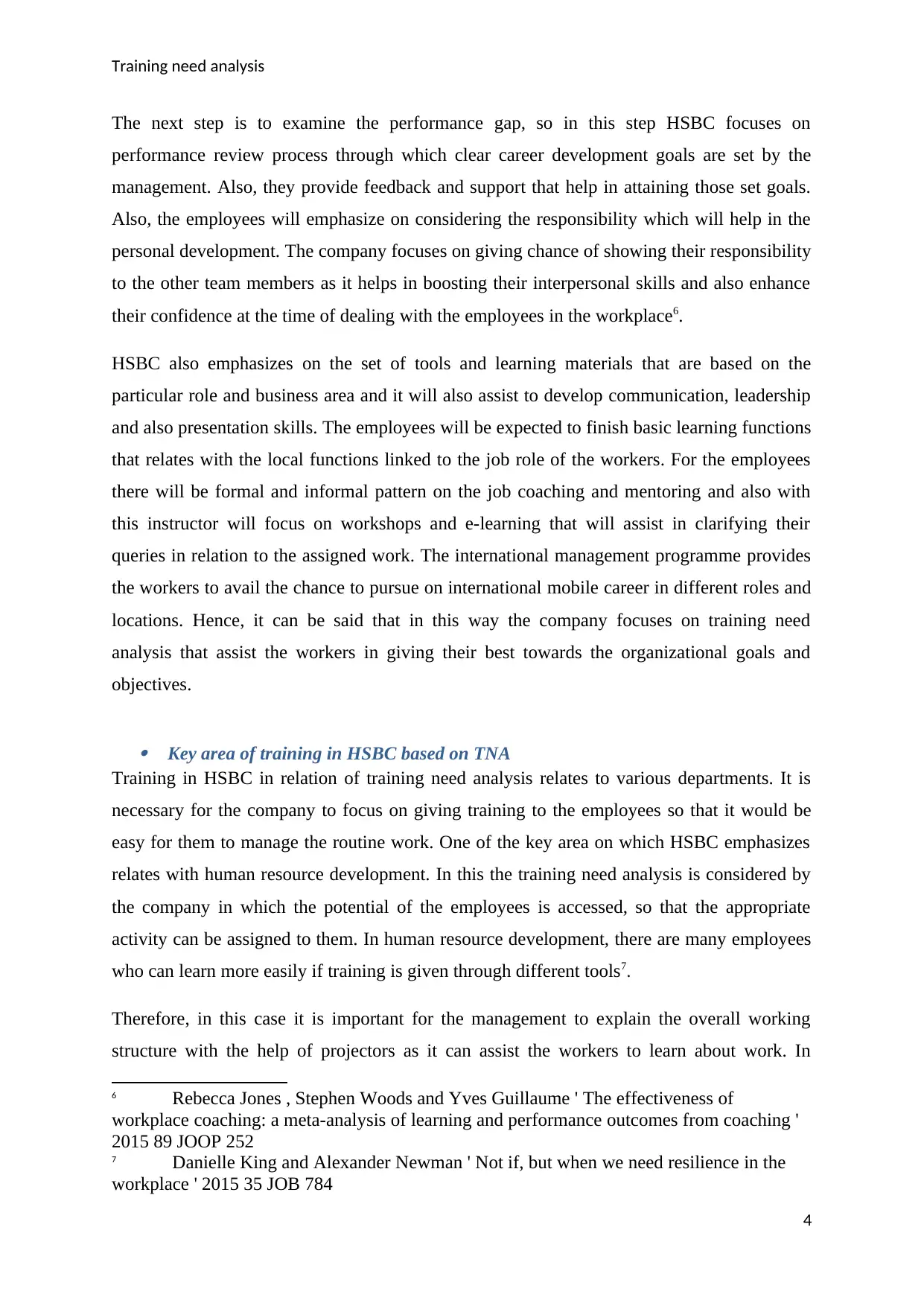
Training need analysis
The next step is to examine the performance gap, so in this step HSBC focuses on
performance review process through which clear career development goals are set by the
management. Also, they provide feedback and support that help in attaining those set goals.
Also, the employees will emphasize on considering the responsibility which will help in the
personal development. The company focuses on giving chance of showing their responsibility
to the other team members as it helps in boosting their interpersonal skills and also enhance
their confidence at the time of dealing with the employees in the workplace6.
HSBC also emphasizes on the set of tools and learning materials that are based on the
particular role and business area and it will also assist to develop communication, leadership
and also presentation skills. The employees will be expected to finish basic learning functions
that relates with the local functions linked to the job role of the workers. For the employees
there will be formal and informal pattern on the job coaching and mentoring and also with
this instructor will focus on workshops and e-learning that will assist in clarifying their
queries in relation to the assigned work. The international management programme provides
the workers to avail the chance to pursue on international mobile career in different roles and
locations. Hence, it can be said that in this way the company focuses on training need
analysis that assist the workers in giving their best towards the organizational goals and
objectives.
Key area of training in HSBC based on TNA
Training in HSBC in relation of training need analysis relates to various departments. It is
necessary for the company to focus on giving training to the employees so that it would be
easy for them to manage the routine work. One of the key area on which HSBC emphasizes
relates with human resource development. In this the training need analysis is considered by
the company in which the potential of the employees is accessed, so that the appropriate
activity can be assigned to them. In human resource development, there are many employees
who can learn more easily if training is given through different tools7.
Therefore, in this case it is important for the management to explain the overall working
structure with the help of projectors as it can assist the workers to learn about work. In
6 Rebecca Jones , Stephen Woods and Yves Guillaume ' The effectiveness of
workplace coaching: a meta-analysis of learning and performance outcomes from coaching '
2015 89 JOOP 252
7 Danielle King and Alexander Newman ' Not if, but when we need resilience in the
workplace ' 2015 35 JOB 784
4
The next step is to examine the performance gap, so in this step HSBC focuses on
performance review process through which clear career development goals are set by the
management. Also, they provide feedback and support that help in attaining those set goals.
Also, the employees will emphasize on considering the responsibility which will help in the
personal development. The company focuses on giving chance of showing their responsibility
to the other team members as it helps in boosting their interpersonal skills and also enhance
their confidence at the time of dealing with the employees in the workplace6.
HSBC also emphasizes on the set of tools and learning materials that are based on the
particular role and business area and it will also assist to develop communication, leadership
and also presentation skills. The employees will be expected to finish basic learning functions
that relates with the local functions linked to the job role of the workers. For the employees
there will be formal and informal pattern on the job coaching and mentoring and also with
this instructor will focus on workshops and e-learning that will assist in clarifying their
queries in relation to the assigned work. The international management programme provides
the workers to avail the chance to pursue on international mobile career in different roles and
locations. Hence, it can be said that in this way the company focuses on training need
analysis that assist the workers in giving their best towards the organizational goals and
objectives.
Key area of training in HSBC based on TNA
Training in HSBC in relation of training need analysis relates to various departments. It is
necessary for the company to focus on giving training to the employees so that it would be
easy for them to manage the routine work. One of the key area on which HSBC emphasizes
relates with human resource development. In this the training need analysis is considered by
the company in which the potential of the employees is accessed, so that the appropriate
activity can be assigned to them. In human resource development, there are many employees
who can learn more easily if training is given through different tools7.
Therefore, in this case it is important for the management to explain the overall working
structure with the help of projectors as it can assist the workers to learn about work. In
6 Rebecca Jones , Stephen Woods and Yves Guillaume ' The effectiveness of
workplace coaching: a meta-analysis of learning and performance outcomes from coaching '
2015 89 JOOP 252
7 Danielle King and Alexander Newman ' Not if, but when we need resilience in the
workplace ' 2015 35 JOB 784
4
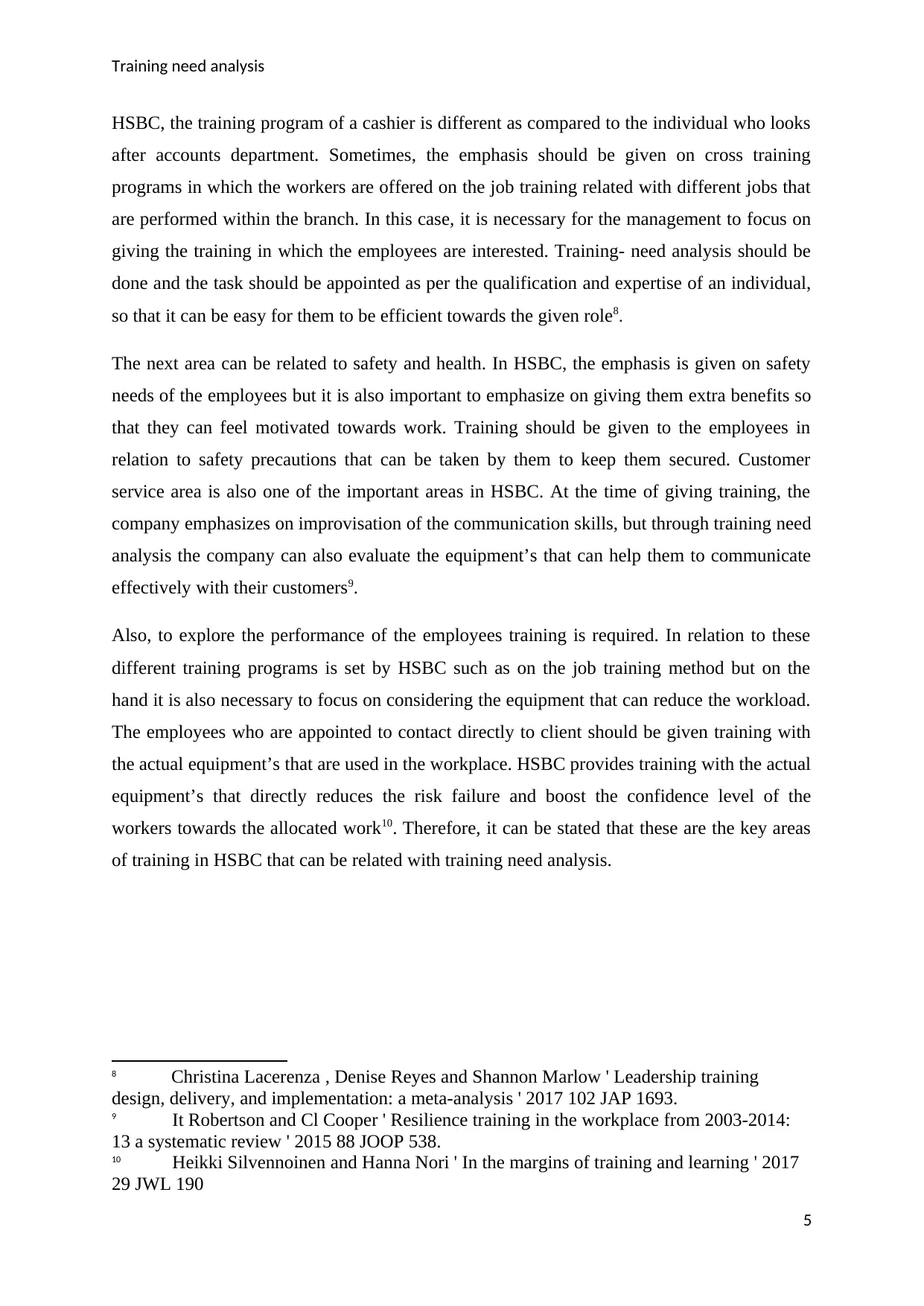
Training need analysis
HSBC, the training program of a cashier is different as compared to the individual who looks
after accounts department. Sometimes, the emphasis should be given on cross training
programs in which the workers are offered on the job training related with different jobs that
are performed within the branch. In this case, it is necessary for the management to focus on
giving the training in which the employees are interested. Training- need analysis should be
done and the task should be appointed as per the qualification and expertise of an individual,
so that it can be easy for them to be efficient towards the given role8.
The next area can be related to safety and health. In HSBC, the emphasis is given on safety
needs of the employees but it is also important to emphasize on giving them extra benefits so
that they can feel motivated towards work. Training should be given to the employees in
relation to safety precautions that can be taken by them to keep them secured. Customer
service area is also one of the important areas in HSBC. At the time of giving training, the
company emphasizes on improvisation of the communication skills, but through training need
analysis the company can also evaluate the equipment’s that can help them to communicate
effectively with their customers9.
Also, to explore the performance of the employees training is required. In relation to these
different training programs is set by HSBC such as on the job training method but on the
hand it is also necessary to focus on considering the equipment that can reduce the workload.
The employees who are appointed to contact directly to client should be given training with
the actual equipment’s that are used in the workplace. HSBC provides training with the actual
equipment’s that directly reduces the risk failure and boost the confidence level of the
workers towards the allocated work10. Therefore, it can be stated that these are the key areas
of training in HSBC that can be related with training need analysis.
8 Christina Lacerenza , Denise Reyes and Shannon Marlow ' Leadership training
design, delivery, and implementation: a meta-analysis ' 2017 102 JAP 1693.
9 It Robertson and Cl Cooper ' Resilience training in the workplace from 2003-2014:
13 a systematic review ' 2015 88 JOOP 538.
10 Heikki Silvennoinen and Hanna Nori ' In the margins of training and learning ' 2017
29 JWL 190
5
HSBC, the training program of a cashier is different as compared to the individual who looks
after accounts department. Sometimes, the emphasis should be given on cross training
programs in which the workers are offered on the job training related with different jobs that
are performed within the branch. In this case, it is necessary for the management to focus on
giving the training in which the employees are interested. Training- need analysis should be
done and the task should be appointed as per the qualification and expertise of an individual,
so that it can be easy for them to be efficient towards the given role8.
The next area can be related to safety and health. In HSBC, the emphasis is given on safety
needs of the employees but it is also important to emphasize on giving them extra benefits so
that they can feel motivated towards work. Training should be given to the employees in
relation to safety precautions that can be taken by them to keep them secured. Customer
service area is also one of the important areas in HSBC. At the time of giving training, the
company emphasizes on improvisation of the communication skills, but through training need
analysis the company can also evaluate the equipment’s that can help them to communicate
effectively with their customers9.
Also, to explore the performance of the employees training is required. In relation to these
different training programs is set by HSBC such as on the job training method but on the
hand it is also necessary to focus on considering the equipment that can reduce the workload.
The employees who are appointed to contact directly to client should be given training with
the actual equipment’s that are used in the workplace. HSBC provides training with the actual
equipment’s that directly reduces the risk failure and boost the confidence level of the
workers towards the allocated work10. Therefore, it can be stated that these are the key areas
of training in HSBC that can be related with training need analysis.
8 Christina Lacerenza , Denise Reyes and Shannon Marlow ' Leadership training
design, delivery, and implementation: a meta-analysis ' 2017 102 JAP 1693.
9 It Robertson and Cl Cooper ' Resilience training in the workplace from 2003-2014:
13 a systematic review ' 2015 88 JOOP 538.
10 Heikki Silvennoinen and Hanna Nori ' In the margins of training and learning ' 2017
29 JWL 190
5
⊘ This is a preview!⊘
Do you want full access?
Subscribe today to unlock all pages.

Trusted by 1+ million students worldwide
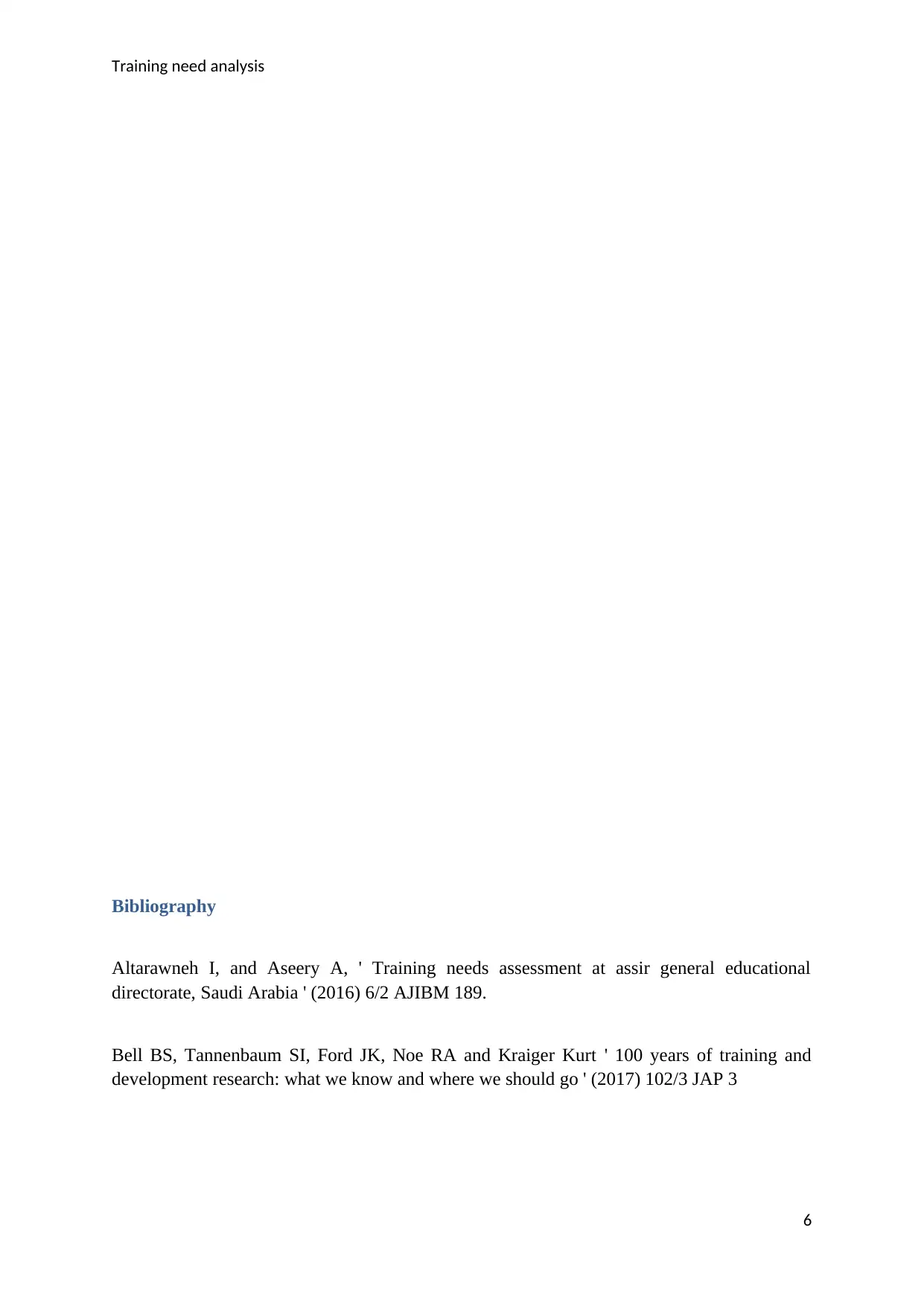
Training need analysis
Bibliography
Altarawneh I, and Aseery A, ' Training needs assessment at assir general educational
directorate, Saudi Arabia ' (2016) 6/2 AJIBM 189.
Bell BS, Tannenbaum SI, Ford JK, Noe RA and Kraiger Kurt ' 100 years of training and
development research: what we know and where we should go ' (2017) 102/3 JAP 3
6
Bibliography
Altarawneh I, and Aseery A, ' Training needs assessment at assir general educational
directorate, Saudi Arabia ' (2016) 6/2 AJIBM 189.
Bell BS, Tannenbaum SI, Ford JK, Noe RA and Kraiger Kurt ' 100 years of training and
development research: what we know and where we should go ' (2017) 102/3 JAP 3
6
Paraphrase This Document
Need a fresh take? Get an instant paraphrase of this document with our AI Paraphraser
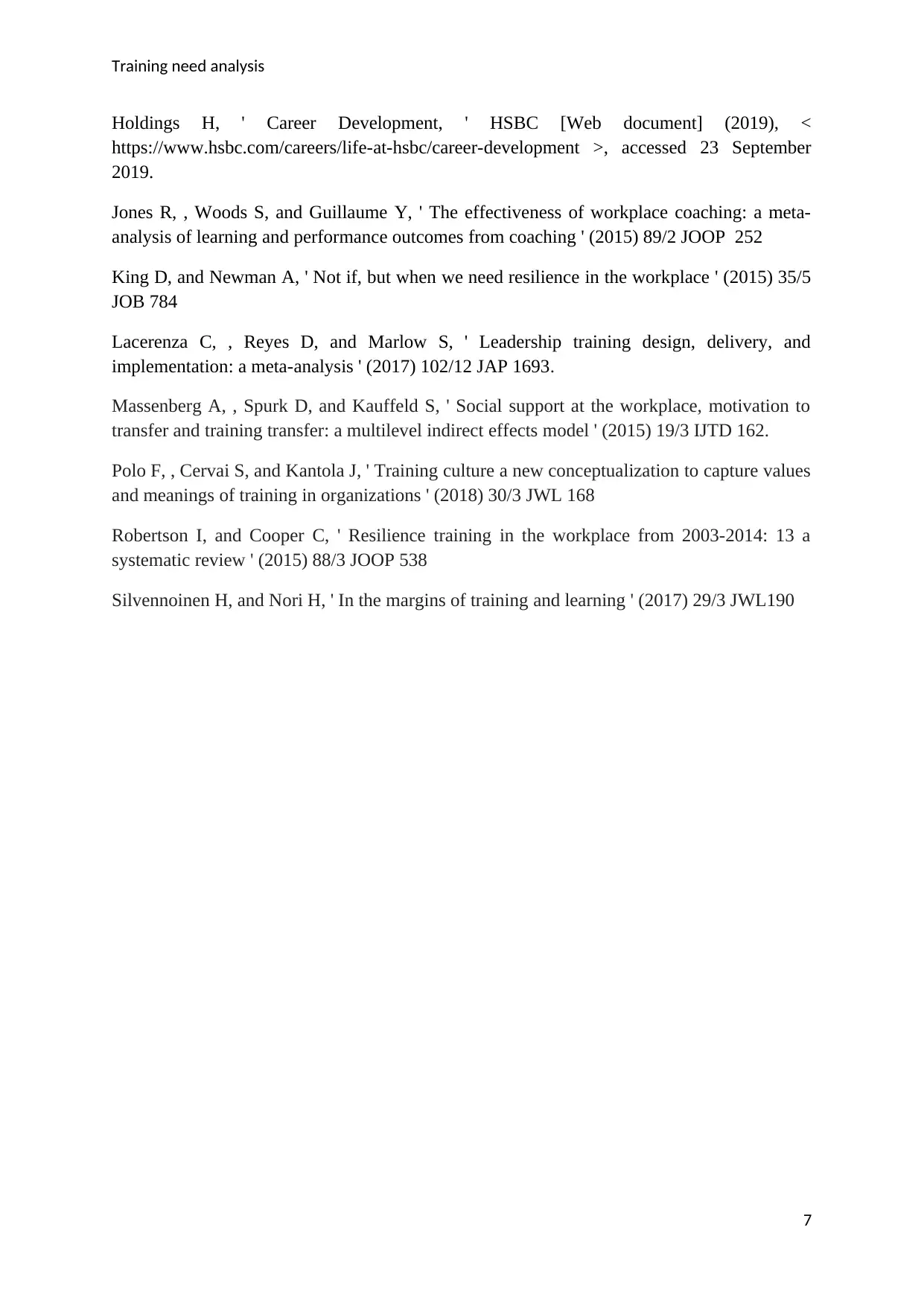
Training need analysis
Holdings H, ' Career Development, ' HSBC [Web document] (2019), <
https://www.hsbc.com/careers/life-at-hsbc/career-development >, accessed 23 September
2019.
Jones R, , Woods S, and Guillaume Y, ' The effectiveness of workplace coaching: a meta-
analysis of learning and performance outcomes from coaching ' (2015) 89/2 JOOP 252
King D, and Newman A, ' Not if, but when we need resilience in the workplace ' (2015) 35/5
JOB 784
Lacerenza C, , Reyes D, and Marlow S, ' Leadership training design, delivery, and
implementation: a meta-analysis ' (2017) 102/12 JAP 1693.
Massenberg A, , Spurk D, and Kauffeld S, ' Social support at the workplace, motivation to
transfer and training transfer: a multilevel indirect effects model ' (2015) 19/3 IJTD 162.
Polo F, , Cervai S, and Kantola J, ' Training culture a new conceptualization to capture values
and meanings of training in organizations ' (2018) 30/3 JWL 168
Robertson I, and Cooper C, ' Resilience training in the workplace from 2003-2014: 13 a
systematic review ' (2015) 88/3 JOOP 538
Silvennoinen H, and Nori H, ' In the margins of training and learning ' (2017) 29/3 JWL190
7
Holdings H, ' Career Development, ' HSBC [Web document] (2019), <
https://www.hsbc.com/careers/life-at-hsbc/career-development >, accessed 23 September
2019.
Jones R, , Woods S, and Guillaume Y, ' The effectiveness of workplace coaching: a meta-
analysis of learning and performance outcomes from coaching ' (2015) 89/2 JOOP 252
King D, and Newman A, ' Not if, but when we need resilience in the workplace ' (2015) 35/5
JOB 784
Lacerenza C, , Reyes D, and Marlow S, ' Leadership training design, delivery, and
implementation: a meta-analysis ' (2017) 102/12 JAP 1693.
Massenberg A, , Spurk D, and Kauffeld S, ' Social support at the workplace, motivation to
transfer and training transfer: a multilevel indirect effects model ' (2015) 19/3 IJTD 162.
Polo F, , Cervai S, and Kantola J, ' Training culture a new conceptualization to capture values
and meanings of training in organizations ' (2018) 30/3 JWL 168
Robertson I, and Cooper C, ' Resilience training in the workplace from 2003-2014: 13 a
systematic review ' (2015) 88/3 JOOP 538
Silvennoinen H, and Nori H, ' In the margins of training and learning ' (2017) 29/3 JWL190
7
1 out of 8
Related Documents
Your All-in-One AI-Powered Toolkit for Academic Success.
+13062052269
info@desklib.com
Available 24*7 on WhatsApp / Email
![[object Object]](/_next/static/media/star-bottom.7253800d.svg)
Unlock your academic potential
Copyright © 2020–2025 A2Z Services. All Rights Reserved. Developed and managed by ZUCOL.




